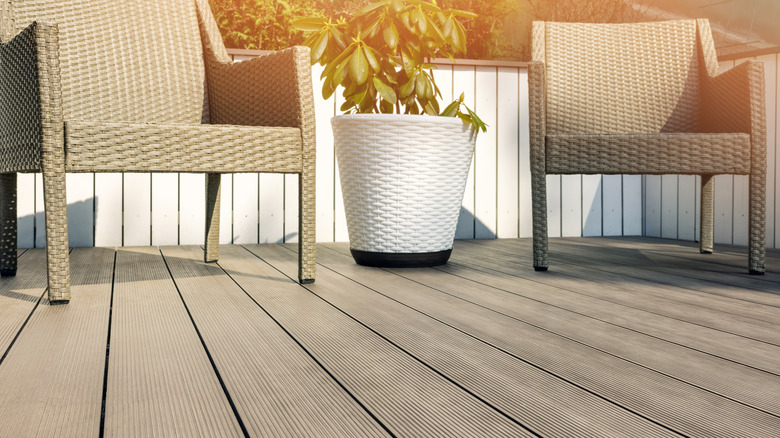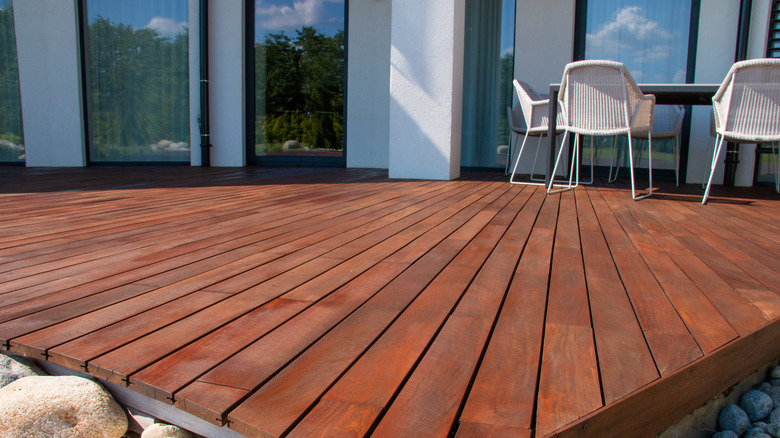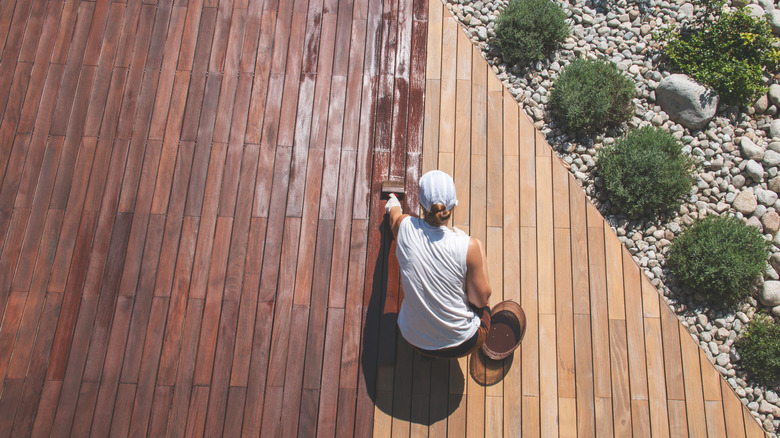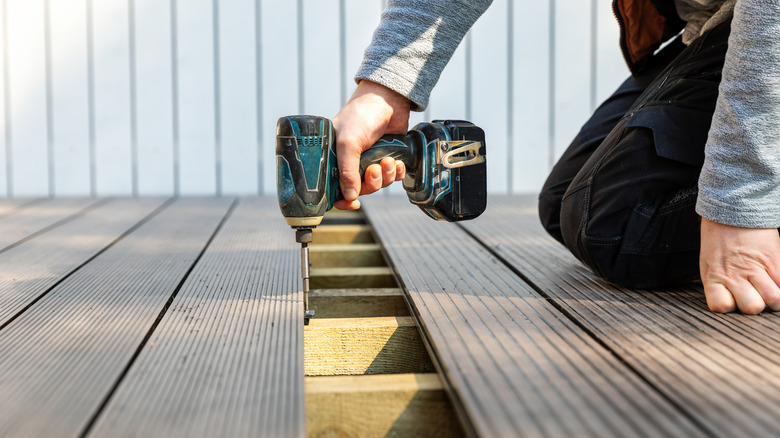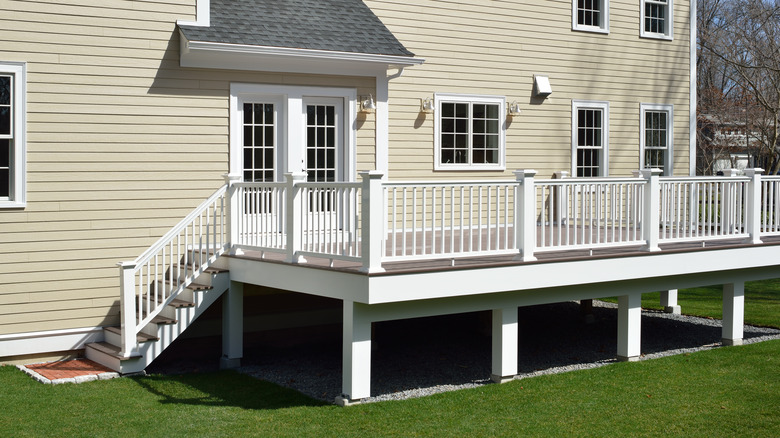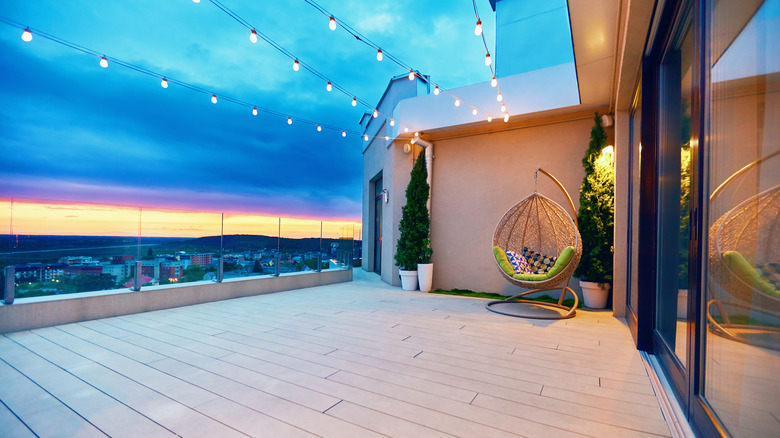How Much Does It Cost To Build A Deck From Scratch
Decking provides a home with a new element of quality and a fantastic space to incorporate outdoor relaxation into daily life. Constructing a new deck can take on a few different approaches and finishing touches, but the end result remains the same. Depending on your home's layout, expectations for the build, and the surrounding property space available, you might consider building a deck that extends out into the backyard or even one that wraps around the home to offer a timeless and luxurious feel, Rogall Painting recommends.
DecksGo estimates that a basic deck build will cost around $25 per square foot to hire a professional contractor and between $8 and $10 per square foot to take on the project yourself. Indeed, building a deck is a great value addition to the home for both those who have spent a significant amount of time honing DIY building skills and those who would rely on a contractor. Besides, adding deck space to your home's footprint can give you and your loved ones some much-needed exterior space free of the dirt and pest components of a grassy relaxation area. Whether approaching this addition in the front or back of the home, a new deck build is an excellent beautification upgrade. It can elevate your lifestyle and the overall appeal of your property.
Factors for cost
When starting a new deck-building project, it's important to consider the primary cost factors. Whether you're building your own deck or hiring a professional, these installations can be modest or entirely grand. Of course, the scale of any renovation will dictate its overall price tag, but when it comes to an external deck, there are some unique considerations to focus on.
Consult with local codes to get the foundation set correctly
Hunker claims that around half of all decks built onto U.S. homes are not built to code (among a figure of about 40 million). Each local jurisdiction will have its own nuanced regulations, but, in general, an exterior deck will require concrete footings that are sunk at least 12 inches — or below the frost line, which can vary immensely (Hunker reports that Minnesota code requires a footing that is anchored at least 48 inches).
Decks.com notes that most states comply in large part with International Code Council (ICC) standards when it comes to building, and this includes the addition of a deck and permitting guidelines surrounding it. This means that for most projects, ensuring compliance with this set of standards will allow you to construct a structurally sound and locally approved deck (barring the stress of an unannounced spot inspection and potential repercussions associated with an unpermitted home addition).
Basic landscaping may be required to prepare the area for construction
For homeowners looking to create a raised deck, preparing the ground beneath the beams is just as important as laying in the foundation and setting the floor. Trex Rain Escape suggests using a paver or other type of added layer to the ground beneath your deck. The space beneath any deck can quickly become unruly if left to its own devices. This is because grass, weeds, and other growth in this area will often be left unchecked. At a bare minimum, it's important to rake out grass and other plant life in the area you'll be building your new deck. Underneath the raised deck, you'll have lots of space for storage and organizational needs; but this will only remain the case if you prepare in advance for the inevitable growth that will try to return. Before pouring the foundation or laying any wooden beams, preparing the ground will give you access to many great new features that wouldn't be possible otherwise.
Many homeowners incorporate one option into their deck space: a storage upgrade. Better Homes & Gardens suggests using simple carpentry to create a storage hatch or hinged skirting around the base for easy access to the space beneath your deck. By combining access points in this space that is primed for use as additional exterior storage, homeowners can take advantage of new decking in more ways than one. However, the time and energy required to remove existing plant life from the target area can be extensive. Forbes Advisor estimates that a smaller job (like weeding, small stump removal, or the removal of a contained area of grass) can cost as little as $50, but the average spend on landscaping services runs around $700.
Lumber costs can vary depending on location and ongoing market factors
Trading Economics shows historical data that suggests a short-term cooling off of the market, with a yearly pricing change of -28.55% (as of April 26, 2022). But these prices remain inflated concerning long-running averages, and Fortune reported back in September (just before a second bubble began to form) that consumers in the market for building materials may not be facing a market that has come back down to stable equilibrium yet. Forbes Advisor recommends long-term planning for any home improvement project due to similar pricing inflations across both local and national marketplaces. The way that goods are manufactured and moved in meaningful and hidden ways is yet to be fully realized by resellers and consumers alike as it changes permanently. Planning for a renovation that will make extensive use of products that are susceptible to intense price swings should be conducted months in advance of any potential start date to capture the best possible cost basis.
A professional can speed up the build considerably but will cost a premium
Hiring a contractor to build your deck is the best way to ensure that the job is done right and erase any physical or mental hardships that can come along with a large-scale construction project on your property. As a result, homeowners have leaned into the DIY process, with sales at DIY-focused retailers jumping by almost $30 billion from 2019 to 2020, signaling a steady increase more broadly since 2013 (via Statista). However, building this type of amenity on your own can take months of planning and physical effort, and with the crucial need to level and square each component of the build, there is a lot that can go wrong for a homeowner trying their hand at residential construction.
Nerd Wallet reports that the average cost to install a professional deck at home is $14,360, while the typical spend for decking in 2017 (taken from a U.S. Census survey, according to Nerd Wallet) was only about $2,500. This large price gap can only be a result of home-built decks versus a professional installation, and considering the aforementioned rate of noncompliance (at about 50%) with standardized building codes, a cost-cutting deck build could save you money today but leave you with a failing home feature that doesn't serve its purpose and cost you considerable time and money to create.
Additional costs
Once you've begun to plan your deck build and perhaps laid the foundation, you'll need to start thinking about additional costs to the project.
Premium construction materials and finishing touches will add to the price tag
More often than not, a residential deck will be built from pressure-treated wood (via decks.com). These woods are relatively low-cost, and the preparation that goes into pressure-treated lumber involves other stages that inoculate the building material against rot and insect invasion. This is important for homeowners trying to make the most of the many years that the deck will hopefully provide. In addition to pressure-treated lumber or other wood choices, Bob Vila provides a great primer for sealing your deck for maximum longevity (which should be done roughly once every year after the initial installation).
For homeowners looking to incorporate a unique element into the build, use cedar or a specialty hardwood like mahogany ($6 to $30 per board foot, via The Pricer, or walnut ($3 to $10 per board foot, according to Wood Working Clarity) can give you a step up in terms of style and visual appeal. Hardwoods contain natural oils and tannins that give them a distinctive look. The natural hardness that is an emblematic feature of these wood options provides built-in resistance to the very factors that pressure-treated lumber must be treated.
Redesigning the yard around your new deck is often necessary
Landscaping comes in two phases when building a new deck. Initially, you'll need to remove obstructions that can cause problems during the building process. But once the deck is finished, your yard will often be left with bare spaces around the newly constructed feature. Forbes Advisor estimates a per hour price of $50 to $100 per hour for a two-person landscaping team, with the typical spend here coming in at $700 and ranging from as little as $50 to upwards of $7,000 for a total lawn overhaul.
A new landscaping design can be as simple as laying some new sod in the disturbed areas around the deck, or it can incorporate garden beds, tree planting, and much more. Homeowners have free reign to build out their lawns, gardens, and other yard elements in any way they see fit, and there are countless inspirations that you can draw from as you reimagine your landscaping after a deck addition (via The Spruce).
Furniture and added amenities tie a new deck together
Living Cozy estimates that outdoor couch units start at about $1,300, while The New York Times outlines a number of great table options that ring up at less than $800. Once you've added these two big-ticket items, you can start thinking about additional lounge chairs, an end table, and even umbrella pieces. A deck is simply a platform for opportunity if it doesn't utilize furniture that can facilitate the comfort and relaxation that you're looking for in the construction. The Spruce suggests Home Depot, Lowes, and Wayfair as perennial favorites. However, a consistent note surrounding each outlet claims that seasonal changes can play a large role in stock availability. Gardeningetc recommends hunting for bargains outside of the primary season that a piece of furniture may be the most useful in order to get the best deal, but this isn't always simple.
Decking types
Your new deck can take on many different styles, but some of the favorites for homeowners are simple paver patios that won't require a platform lift and raised wooden decking that gives the home an elevated sense of luxury.
Paver patios can be incredibly luxurious
A patio built with pavers can add a unique sense of luxury to your home. Pavers are essentially exterior tiles constructed from concrete, stone, or clay and can be interlaid in intricate patterns that lend themselves to a unique design. Making use of two-color tones can add a new dimension of depth to the patterns that are possible, too. Carmel Imports reports that pavers are incredibly durable and naturally adapt to seasonal changes that can crack or warp a poured concrete slab over many years. However, because pavers incorporate natural creases between each tile, a poorly maintained paver patio can be susceptible to weed growth that can widen the gaps present until the deck must be reestablished with new foundational elements. Sand is typically used to fill in these crevices, so for a homeowner looking to install a paver deck, keeping a supply of additional sand at the ready is a great way to ensure that routine maintenance on the surface is kept simple and light.
LawnStarter estimates the cost of a paver deck at an average of $4,537 with a range running from $3,476 to $8,872 (and a square foot cost between $8.69 and $22.18 per square foot). This makes pavers a great option that can save on the overall price of a new decking installation and provide a long-lasting solution for your home and family.
Raised wooden decking is a favorite for several reasons
Raised wooden decks are some of the most iconic outdoor activity spaces that homeowners can bring into the outline of their property. According to Bob Vila, the national average for this type of construction is $7,696. In contrast, a second-floor addition of the same type will cost around 30% to 60% more after including essential lumber additions and required stabilization elements. Raised decking provides the essential outdoor storage facilities that many homeowners looking to take advantage of their yards will require, delivering about a 70% return on investment (via Remodeling Calculator).
Wraparound decks offer a time-honored look
The Spruce reports that a wraparound deck can be incorporated into the structure of a home to provide for a more scenic view of the surrounding landscape while activating more of your home's interior space. This type of deck construction helps link different sides of the home with access to the exterior relaxation space. It's well-documented that outdoor areas that tie directly into interior living spaces can make the home feel more comfortable, airy and bright, and even larger (via Real Homes).
Why you need a new deck at home
Adding a new deck to your home can change the way you think about your property's value to your family's lifestyle. A new deck that brings outdoor living to the forefront is often a cost-effective undertaking compared to other home improvement projects. It can truly transform the enjoyment you experience every day.
Comfort is key to any homeowner's lifestyle
Comfort is one of the primary factors that influence a homeowner's life decisions. The addition of an outdoor living space is a great boost to the comfort and quality of life that you can expect to experience in your home. Patio World reports that spending time outdoors is a great way to improve feelings of positivity and wellness, while extended periods of indoor time can actually increase stress and anxiety. These claims stand up in other testing environments, as Time touts the physiological and psychological changes that take place for the better in individuals who make outdoor living a part of their routine. So, when the warmer months peak out from the waning days of winter, that new deck will likely shine as a cornerstone of your family's daily routine.
Hosting events and gatherings become normal for homeowners with outdoor amenities
Entertaining guests becomes a normal part of a homeowner's routine once they've built this added feature into their property. Better Homes & Gardens suggests that outdoor gatherings provide a more relaxed feel, and on a great day, nothing beats a barbecue and some cold drinks while basking in the sun with friends and loved ones. Adding a deck to your property opens up a world of possibilities when it comes to hosting parties or simply winding down at the end of a long day of work.
Benefits of newly installed decking in your home
New decking can provide a wealth of benefits to a homeowner. Two of the most important additions to a property come in the form of financial return and the enhanced lifestyle that it can provide.
Financial factors should always play a role in home improvement plans
According to Remodeling Calculator, a new decking provides one of the best returns on investment across all subsections of the remodeling and renovation space for a homeowner while clocking in at one of the lowest overall price points among home improvements. No matter where your renovation dreams lie, the importance of financial calculations can't be overstated. Homeowners often think of their property as a one-dimensional asset that functions as a support system for their lifestyle alone. Yet, the home acts as a massive financial resource for homeowners who understand the nuanced benefits that can be extracted from homeownership more broadly.
In all renovation projects, asking yourself where the financial intelligence in the approach lies is an important step toward making smart decisions about your home and personal finances that are crucial to supporting your entire family's health and wellness. A deck is a great addition to any home for a property owner seeking a boosted resale value and the natural increase in comfort and quality of life that this installation can bring in the meantime.
Enhanced enjoyment in your home environment lies at the heart of this new installation
In addition to the financial balm that a new deck offers, this outdoor relaxation space is one of the most important assets that a homeowner can bring to the table when seeking a calming environment and a taste of the good life for themselves and their family. Considering this addition to your property is a great way to quickly and effectively transform the essence of your property for the better.
